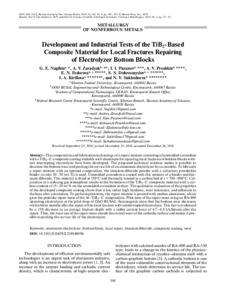Показать сокращенную информацию
Development and Industrial Tests of the TiB2-Based Composite Material for Local Fractures Repairing of Electrolyzer Bottom Blocks
| Автор | Nagibin, G. E. | |
| Автор | Zavadyak, A. V. | |
| Автор | Puzanov, I. I. | |
| Автор | Proshkin, A. V. | |
| Автор | Fedorova, E. N. | |
| Автор | Dobrosmyslov, S. S. | |
| Автор | Kirillova, I. A. | |
| Автор | Sukhodoeva, N. V. | |
| Дата внесения | 2020-01-20T08:00:27Z | |
| Дата, когда ресурс стал доступен | 2020-01-20T08:00:27Z | |
| Дата публикации | 2019-07 | |
| Библиографическое описание | Nagibin, G. E. Development and Industrial Tests of the TiB2-Based Composite Material for Local Fractures Repairing of Electrolyzer Bottom Blocks [Текст] / G. E. Nagibin, A. V. Zavadyak, I. I. Puzanov, A. V. Proshkin, E. N. Fedorova, S. S. Dobrosmyslov, I. A. Kirillova, N. V. Sukhodoeva // Russian Journal of Non-Ferrous Metals. — 2019. — Т. 60 (№ 4). — С. 348-353 | |
| ISSN | 10678212 | |
| URI (для ссылок/цитирований) | https://link.springer.com/article/10.3103/S1067821219040096 | |
| URI (для ссылок/цитирований) | https://elib.sfu-kras.ru/handle/2311/129462 | |
| Аннотация | The composition and fabrication technology of a repair mixture consisting of unmolded corundum with a TiB2–C composite coating wettable with aluminum for repairing local fractures of bottom blocks without interrupting electrolysis have been developed. The proposed technical solution makes it possible to decrease the bottom wear and prolong the service life of an aluminum electrolyzer by six months. To fabricate a repair mixture with an optimal composition, the titanium diboride powder with a refractory powderlike binder in ratio 50 : 50 (wt %) is used. Unmolded corundum is coated with this mixture of a binder and tita- nium diboride. This material is dried at 150 ° C and thermally treated in a carbon bed at t = 700–900 ° C. Calcination in a reducing gas atmosphere results in the formation of the TiB2 –C composite material with a carbon content of 15–20 wt % on the unmolded corundum surface. The qualitative evaluation of the properties of the developed composite coating shows that it has rather high hardness, wear resistance, and adhesion to the base after calcination. To perform pilot tests, the repair mixture is poured with molten aluminum, which gives the platelike repair mass of the Al–TiB2 –C composition. Pilot tests of the repair mass using an RA-400 operating electrolyzer at the pilot shop of OAO RUSAL-Sayanogorsk show that the bottom wear decreases within three months after the repair of the local fracture with uninterrupted electrolysis. This fact is evidenced by a 13% decrease in an average fracture depth with a stable current force of 4.7–4.8 kA/bloom after the repair. Thus, the local use of the repair mass retards the overall wear of the cathodic surface and makes it possible to prolong the service life of the electrolyzer. | |
| Тема | aluminum electrolyzer | |
| Тема | bottom block | |
| Тема | local repair | |
| Тема | titanium diboride | |
| Тема | composite coating | |
| Тема | wear | |
| Название | Development and Industrial Tests of the TiB2-Based Composite Material for Local Fractures Repairing of Electrolyzer Bottom Blocks | |
| Тип | Journal Article | |
| Тип | Journal Article Preprint | |
| Страницы | 348-353 | |
| ГРНТИ | 53.01.83 | |
| Дата обновления | 2020-01-20T08:00:27Z | |
| DOI | 10.3103/S1067821219040096 | |
| Институт | Политехнический институт | |
| Институт | Инженерно-строительный институт | |
| Подразделение | Кафедра прикладной механики | |
| Подразделение | Кафедра проектирования зданий и экспертизы недвижимости | |
| Журнал | Russian Journal of Non-Ferrous Metals | |
| Квартиль журнала в Scopus | Q2 | |
| Квартиль журнала в Web of Science | Q4 |

